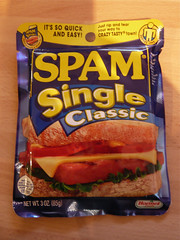Have you noticed an increase in SPAM comments on your blog? In the past few months, I've been hit hard. I've also noticed the people doing it have a few new tricks. Historically, I used to get comments full of links and text with no relation to my post topic or even to my blog – obvious SPAM. It's becoming a lot harder to spot the dodgy comments but they do have common features.
Becoming familiar with the tactics of the SPAMMER is the first step to keeping unwanted messages off your own blog. The last thing I want to do is support these people or the companies using their services. To identify a SPAM comment, look for these attributes:
- 1) First name only Legitimate people leave both their first and last name. SPAMMERs go out of their way to be vague about their identity.
- 2) Everything in lower case These people are spending ALL day on a keyboard. It's a lazy profession and they're often so lazy they can't use a shift key.
- 3) Comments are on old posts SPAM comments are usually attached to posts at least 6 months old.
- 4) One or two sentences at maximum These people aren't going to hang around a long time because they're working on a volume basis. At most you'll get two sentences out of them.
- 5) Grammatical errors It's rare to find a well-crafted SPAM comment; they're usually full of grammatical errors and typos.
- 6) Text scraped off your own site If the text of a comment looks familiar, it's probably SPAM and they probably scraped it right out of the post in question. In other words, they're adding insult to injury and plagiarising your own content.
- 7) Banal, meaningless comment If the text of the comment adds nothing to the discussion then you should suspect a SPAMMER at work. The ubiquitous `great post' is a dead giveaway.
- 8) Titles used as comments If the title of your post is used in the body of comment it's almost always SPAM, e.g. "I always 7 great places to register your rss feed so thanks"
- 9) Link going to sites requiring high traffic The nail in the coffin is always the link supplied with the comment. I've been plagued with casino gambling sites, real estate sites, and wholesale running shoes in the last month.
Bloggers work hard to write engaging copy and develop content to attract readers. Unfortunately, those very efforts make your blog attractive to the underbelly of the web too. As SPAM filters become more sophisticated, the tactics for leaving SPAM comments has changed. Knowing how to recognise them ensures you won't be encouraging their efforts or adding to their profitability.
[/color]The Take-Away[/color]
I've recently gone through my blog and realised some of the early adopters of the new SPAM techniques had found their way onto my blog. With extreme delight, I deleted them all. You might want to have a look at your own comment log and see if you were caught out, as well.
How do you spot a SPAM comment?
Subscribe
Subscribe here to have new posts from the Global Copywriting Blog delivered by email.
Image Credit: 365.298: SPAM by WordRidden, on Flickr



Recent Comments